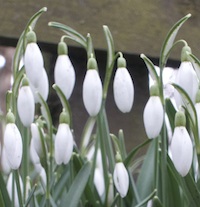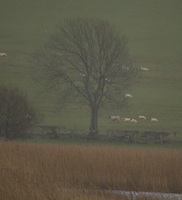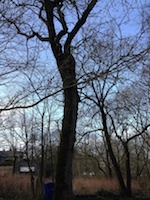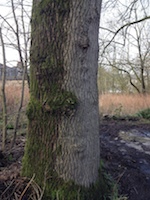February 2016
Snowdrops
27/02/16 14:37
I was pointed towards the BSBI's identification guide for snowdrops recently. In my ignorance I thought a snowdrop was a snowdrop but should have known better.
So armed with the guide off I went to look at the local snowdrops, sadly not wild.

The identifying features are:
leaf width: narrow or broad, i.e. wider or more narrow than the little finger nail
leaf colour: blue-grey or bright green
leaf base: wrap around or flat facing
petal mark: mouth, base, both or solid
Well the key wasn't difficult to apply to the local snowdrops. Leaf narrow is Galanthus nivalis. The next feature is single or double flowers, the double flowered version being G nivalis 'Flore Pleno'. Ours are single, so G nivalis it is then.
The guide continues to describe a wide variety of interesting petal marks, including sad faces and chromosomal patters. Unfortunately ours are not yet fully open so observation of petal markings will have to wait.
So armed with the guide off I went to look at the local snowdrops, sadly not wild.

The identifying features are:
leaf width: narrow or broad, i.e. wider or more narrow than the little finger nail
leaf colour: blue-grey or bright green
leaf base: wrap around or flat facing
petal mark: mouth, base, both or solid
Well the key wasn't difficult to apply to the local snowdrops. Leaf narrow is Galanthus nivalis. The next feature is single or double flowers, the double flowered version being G nivalis 'Flore Pleno'. Ours are single, so G nivalis it is then.
The guide continues to describe a wide variety of interesting petal marks, including sad faces and chromosomal patters. Unfortunately ours are not yet fully open so observation of petal markings will have to wait.
Well-behaved tree?
20/02/16 22:38
Below is a snap of a tree from the Grizedale Hide at Leighton Moss Nature reserve. The prevailing weather comes from the south west, on the right of the snap.

It is doing many of the things the nature books say a tree should:
It has 'overblown' branches on the side of the prevailing weather
it has straggling branches away from the weather, on the north (left) side
It is drier on the south side, to the right of the picture
This latter statement is frequently found in nature books, that a tree is drier on the south side which receives more sunlight. Conversely the trunk is damper with heavier algae and moss growth on the north side, which receives less sun.
It appears that the ash tree on the lane hasn't read the books, as this is noticeably wetter with heavier moss growth on the south. This is probably because the local conditions mean that the prevailing rain comes straight up the lane in a pretty much south-north direction, whilst adjacent trees and houses means that the trunk receives very little direct sunlight.


This demonstrates nicely that local examples don't always follow generalised rules. Just hope nobody uses this to navigate by.

It is doing many of the things the nature books say a tree should:
It has 'overblown' branches on the side of the prevailing weather
it has straggling branches away from the weather, on the north (left) side
It is drier on the south side, to the right of the picture
This latter statement is frequently found in nature books, that a tree is drier on the south side which receives more sunlight. Conversely the trunk is damper with heavier algae and moss growth on the north side, which receives less sun.
It appears that the ash tree on the lane hasn't read the books, as this is noticeably wetter with heavier moss growth on the south. This is probably because the local conditions mean that the prevailing rain comes straight up the lane in a pretty much south-north direction, whilst adjacent trees and houses means that the trunk receives very little direct sunlight.


This demonstrates nicely that local examples don't always follow generalised rules. Just hope nobody uses this to navigate by.
Early spring?
06/02/16 18:25
The BSBI New Year Plant Hunt recorded a record number of plants in flower at New Year. Most of these were autumn stragglers rather than early spring plants. However there has been much speculation that the mild winter may trigger an early spring.
Not here.
The first blackbird song was 23 Jan, a week later than 2015 and 3 weeks later than '2014' when it was actually late Dec 2013.
Snowdrops are not in flower yet, neither are willow catkins out. The willow was flowering in Jan for the last 2 years, the snowdrop out by Feb 1st at latest. It is even looking like the crocus may beat the snowdrop to flower this year, which I've not seen before.
Not sure why this is. I'm toying with the idea of getting a weather station to compare data over time. Another thing to play with…
Not here.
The first blackbird song was 23 Jan, a week later than 2015 and 3 weeks later than '2014' when it was actually late Dec 2013.
Snowdrops are not in flower yet, neither are willow catkins out. The willow was flowering in Jan for the last 2 years, the snowdrop out by Feb 1st at latest. It is even looking like the crocus may beat the snowdrop to flower this year, which I've not seen before.
Not sure why this is. I'm toying with the idea of getting a weather station to compare data over time. Another thing to play with…




